Chess Positions on Stamps
Jon Edwards and Joram Lubianiker
This lengthy exhibit would not be possible without the many contributions on this topic in the ChessStamp Review. I call attention to the long bibliography at the end of the exhibit and particularly to the many articles by Joram Lubianiker.
His studies have identified nearly every game represented by a position on a chess stamp. That effort has eased the production of this exhibit. To complete this effort, I had only to determine the identity of three games (using ChessBase 8.0, of course).
Presenting this information on the web is a natural next step. In addition to the images of the stamps and the consolidation of all of the information, you will find links to the games themselves. Not all of the positions selected for these stamps are the best possible, but there are some wonderful games here! This exhibit will take some time to complete. For the moment, I provide the images of the stamps and all of the games. I will add some descriptive materials for each game, as time allows.
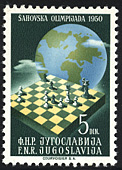 Capablanca v Lasker, New York, 1924
Capablanca v Lasker, New York, 1924
Emanuel Lasker won the 1924 New York tournament, losing only one game to Capablanca. This extremely complex game won the 3rd brilliancy prize. Lasker missed a drawing opportunity with 37...Bf7 rather than 37...Qe6. The game is well annotated in Capablanca's 100 Best Games of Chess.
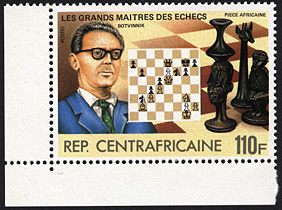 Botvinnik v Capablanca, AVRO, 1938
Botvinnik v Capablanca, AVRO, 1938
In his book: A Half Century of Chess, Botvinnik noted that this position was remembered years later at the World Chess Olympiad in 1954 on a cake displayed in a shop window. The Queen on e7 makes a poor blockader of the passed e6-pawn. White removes the queen by force. 30.Ba3 is the beginning of a beautiful 12-move combination.
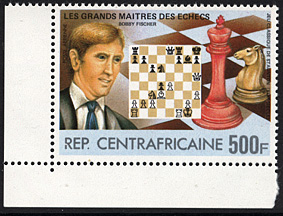 Fischer v Benko, USA ch, 1963
Fischer v Benko, USA ch, 1963
This Fischer win occurred as part of his unprecedented 11-0 victory in the 1963-4 US Championship. In the diagram, it appears that Fischer can play e4-e5 threatening checkmate on h7. But Benko would have been able to respond with ...f5. Fischer therefore uncorks "a bolt from the blue" with Rf6!! with the now unstoppable threat of e4-e5. A wonderful illustration of the timeless chess principle: "The threat is stronger than the execution."
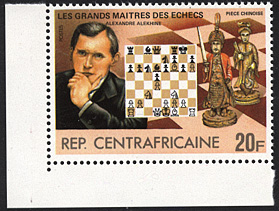 Alekhine v Rubinstein, The Hague, 1921
Alekhine v Rubinstein, The Hague, 1921
Following several eccentricities by Black in the Queen's Gambit, white embarks upon an early attack, moving his h-pawn three times, his dark-squared bishop four times and, after Bf6, probably has a winning position. Alekhine analyzes this game in detail (game 61) in his Best Games of Chess.
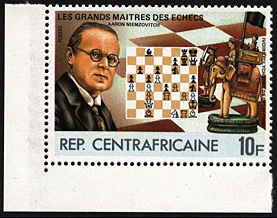 Johner v Nimzovitsch, Dresden, 1926
Johner v Nimzovitsch, Dresden, 1926
Nimzovitsch describes this game as "one of the best blockading games I have ever played" and analyzes it extensively in both My System and Chess Praxis.
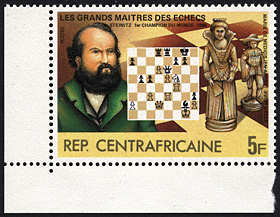 Spassky v Smyslov, Bucharest, 1953
Spassky v Smyslov, Bucharest, 1953
From the stamp, you would expect a game of Steinitz, but the designer placed the wrong diagram on the stamp. The position derives from a Spassky game in 1953, nearly 50 years after Steinitz's death. This Bucharest tournament was the young 16-year-old's first taste of international competition. From the diagram, Spassky, playing white, played 33.Ng7, and Smyslov resigned after 33...Rd6 34.Ne6 Rxd2 35.Rg3. Only a year later, Smyslov scored 12-12 against Botvinnik!
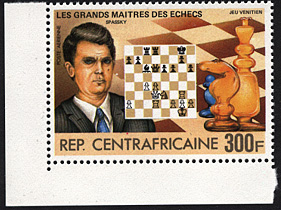 Steinitz v Zukertort, match, 1886
Steinitz v Zukertort, match, 1886
And here is the Steinitz game, the ninth game of his 1886 match against Zukertort.
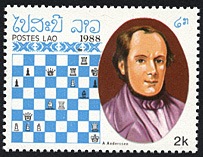 Kolisch v Anderssen, London, match (1), 1861 This 1861 match is better remembered for how it was timed, with an hourglass, than for this particular game. Anderssen lost mis famous match against Morphy in 1858 but bounced back to defeat Kolisch three years later.
Kolisch v Anderssen, London, match (1), 1861 This 1861 match is better remembered for how it was timed, with an hourglass, than for this particular game. Anderssen lost mis famous match against Morphy in 1858 but bounced back to defeat Kolisch three years later.
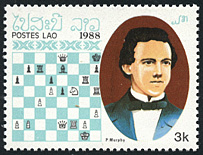 Morphy v Harrwitz, Paris, match (3), 1858 Morphy lost the first two games of this match. According to Edge, Morphy was distracted by the night life in Paris and had very little sleep. After his second defeat, Morphy predicted that Harrwitz would not win another game. Sure enough, Morphy won the next five games and Harrwitz refused to continue to play.
Morphy v Harrwitz, Paris, match (3), 1858 Morphy lost the first two games of this match. According to Edge, Morphy was distracted by the night life in Paris and had very little sleep. After his second defeat, Morphy predicted that Harrwitz would not win another game. Sure enough, Morphy won the next five games and Harrwitz refused to continue to play.
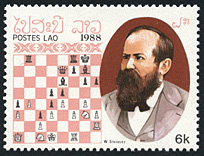 Anderssen v Steinitz, Vienna, 1873 This game is hardly Steinitz's best, despite the strong opponent. The game illustrates Steinitz's positional understanding; Anderssen's queen is structurally out-of-play as early as move 22.
Anderssen v Steinitz, Vienna, 1873 This game is hardly Steinitz's best, despite the strong opponent. The game illustrates Steinitz's positional understanding; Anderssen's queen is structurally out-of-play as early as move 22.
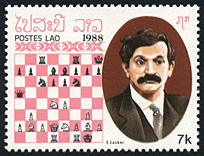 Ilyln Zhenevsky v Lasker, 1925 Again, not the example we would have picked for one of Lasker's best games. Indeed, many annotators believe that white is fine, and perhaps winning by move 23, but Ilyin-Zhenevsky blundered, losing the exchange and the game with 23.Qe3?
Ilyln Zhenevsky v Lasker, 1925 Again, not the example we would have picked for one of Lasker's best games. Indeed, many annotators believe that white is fine, and perhaps winning by move 23, but Ilyin-Zhenevsky blundered, losing the exchange and the game with 23.Qe3?
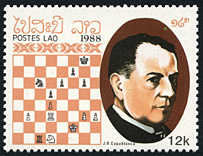 Capablanca v Lasker, Havana, match (10), 1921 The tenth game of the World Championship match, won by Capablanca. In the position on the stamp, Capa avoids a diabolical trap: 23...Nb4 44.Rd2 Rb1 45.Nb2 Rxb2 46.Rxb2 Nd3+ 47.Ke2 Nxb2 48.Kd2 leads to a draw because the black knight is trapped! After 43...Rb1!, 44.Ke1 is a better try but black still wins a pawn with 44...Na5.
Capablanca v Lasker, Havana, match (10), 1921 The tenth game of the World Championship match, won by Capablanca. In the position on the stamp, Capa avoids a diabolical trap: 23...Nb4 44.Rd2 Rb1 45.Nb2 Rxb2 46.Rxb2 Nd3+ 47.Ke2 Nxb2 48.Kd2 leads to a draw because the black knight is trapped! After 43...Rb1!, 44.Ke1 is a better try but black still wins a pawn with 44...Na5.
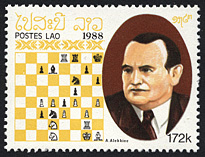 Bogoljubov v Alekhine, Hastings, 1922 One of the greatest games ever played, and well worth study. Beginning with 29.Rxa5, white's rook captures both of black's rooks and black's queen, but is foiled by a single, unstoppable pawn. Perhaps the most amazing shock is 34...Ne1 threatening an original smothered checkmate on f3!
Bogoljubov v Alekhine, Hastings, 1922 One of the greatest games ever played, and well worth study. Beginning with 29.Rxa5, white's rook captures both of black's rooks and black's queen, but is foiled by a single, unstoppable pawn. Perhaps the most amazing shock is 34...Ne1 threatening an original smothered checkmate on f3!
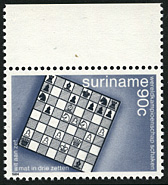 Anderssen v Kieseritzy, 1851
Anderssen v Kieseritzy, 1851
The "Immortal Game." From the position on the stamp, the game ended: 21.Nxg7+ Kd8 22.Qf6+! Nxf6 23.Be7 checkmate! Of this beatuiful game, world champion Emanuel Lasker wrote in his Manual of Chess: "The end of the game is undoubtedly splendid. The checkmate represents a maximal achievement; three minor officers, unaided, execute the incredible mate in the face of the whole hostile army."
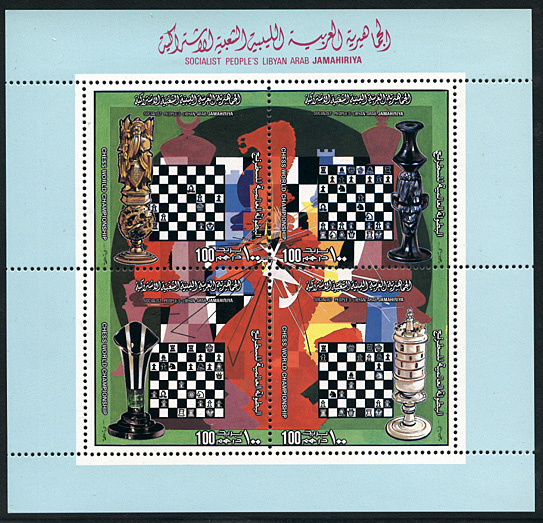
Fischer v Spassky, match (21), 1972
Tal v Vadasz, Talinn, 1977
Karpov v Smyslov, USSR ch, 1971
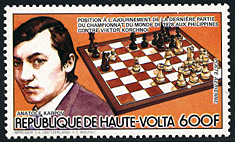 Karpov v Kortchnoi, Baggio, 1978
Karpov v Kortchnoi, Baggio, 1978
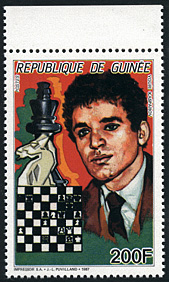 Karpov v Kasparov, match (22), 1986
Karpov v Kasparov, match (22), 1986

Bruhl v Philador, London, 1783
Anderssen v Morphy, Paris, 1858v
Blackburne v Taylor
Lasker v Tarrasch, Germany, 1908
Janowski v Marshall, 1912
Capablanca v Lasker, match (11), 1924
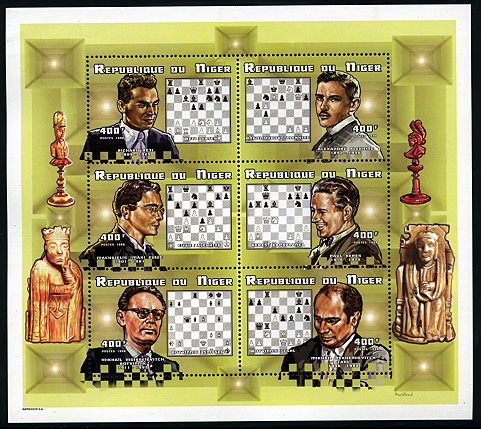
Reti v Yates, New York, 1924
Bogolyubov v Alekhine, match (1), 1929
Euwe v Alekhine, match (26), 1935
Keres v Capablanca, AVRO, 1938
Botvinnik v Smyslov, match (12), 1954
Botvinnik v Tal, match (6), 1960
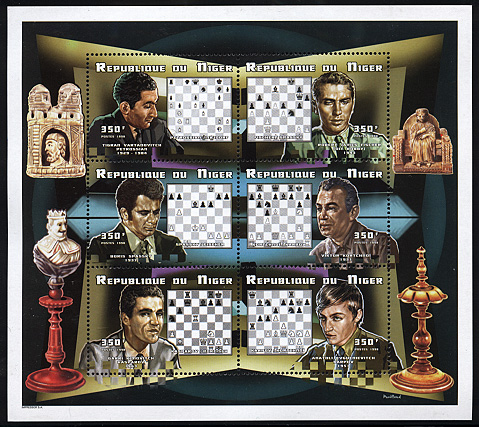
Petrosian v Najdorf, Bled, 1961
Fischer v Spassky, match (1), 1972
Fischer v Spassky, match (5), 1972
Korchnoi v Karpov, match (21), 1974
Karpov v Korchnoi, match (32), 1978
Kasparov v Portisch, Niksic, 1983
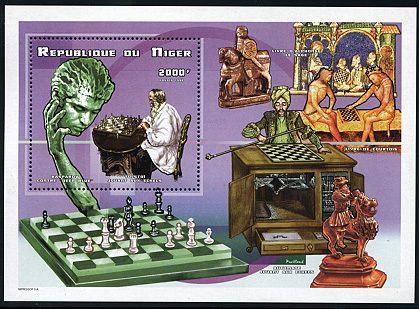
Kasparov v Deep Blue, Philadelphia, 1996
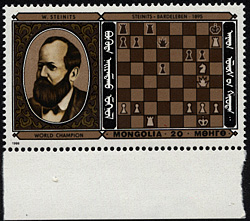 Steinitz v von Barteleben, Hastings, 1895
Steinitz v von Barteleben, Hastings, 1895
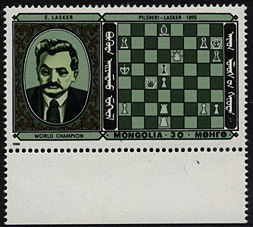 Pillsbury v Lasker, 1895
Pillsbury v Lasker, 1895
Pillsbury never played in a world championship match, but first place showing at Hastings and his victory there against the new World Champion Lasker cements his place as one the world's best ever. Here at St. Peterswburg, Lasker won despite many errors. It was a key victory. Pillsbury lost 5 of his last 8 games. Lasker won the tournament, crushed Steinitz for the World Champioknship, and held that title for 25 years.
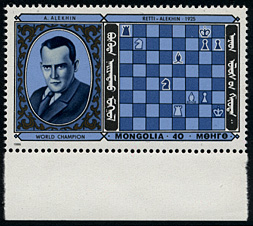 Reti v Alekhine, 1925
Reti v Alekhine, 1925
A game nominated by Kasparov as the most beautiful ever played. Czech Richard Reti advanced chess theory with the idea of challenging an established center rather than fighting for the center from the start. Don't miss black's wonderful 34th move.
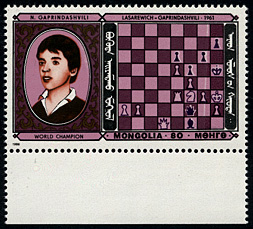 Lazarevic v Gaprindaschvili, 1961
Lazarevic v Gaprindaschvili, 1961
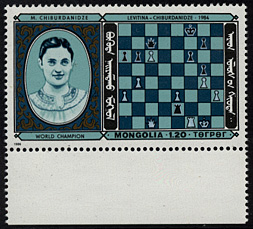 Levitina v Chiburdanidze, 1984
Levitina v Chiburdanidze, 1984
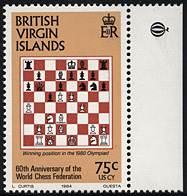 William Hook v Saif Kanani, Olympiad, 1980
William Hook v Saif Kanani, Olympiad, 1980
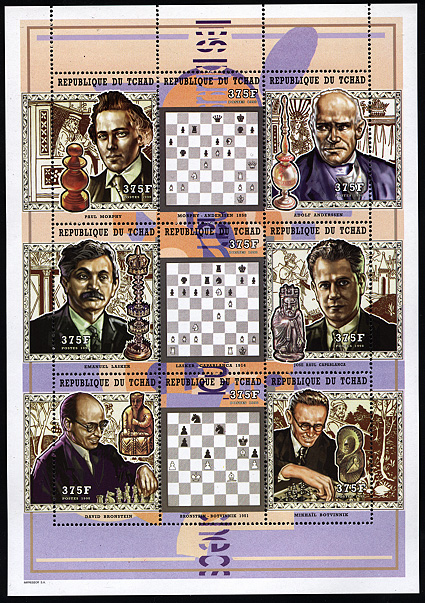
Morphy v Anderssen, Paris, 1858
Lasker v Capablanca, St. Petersburg, 1914
Botvinnik v Bronstein, match (23), 1951
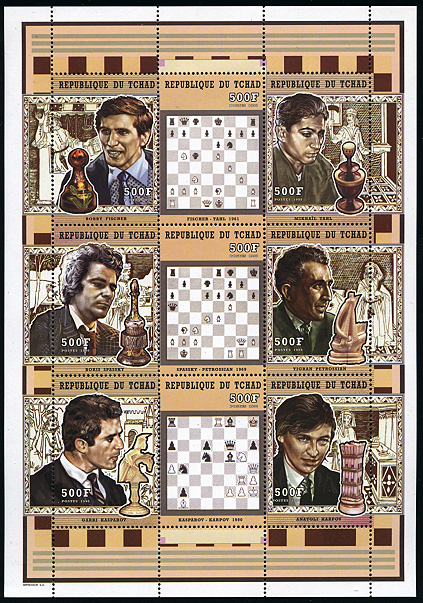
Fischer v Tal, Bled, 1961
Spassky v Petrosian, match (19), 1969
Kasparov v Karpov, match (20), 1990
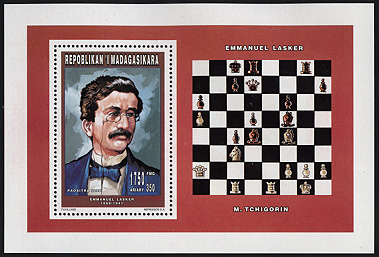
Chigorin v Lasker, St. Petersburg, 1895
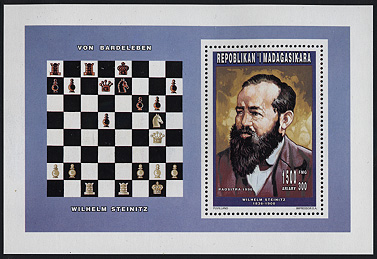
Steinitz v von Barteleben, Hastings, 1895
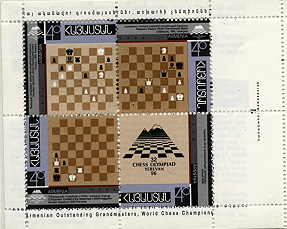
Kasparov v Karpov, match (22), 1986
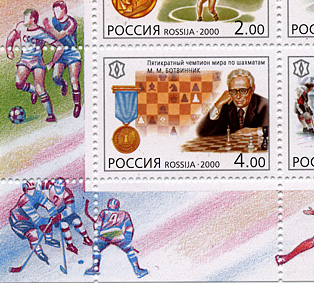
Denker v Botvinnik, USA-USSR radio match (1), 1945
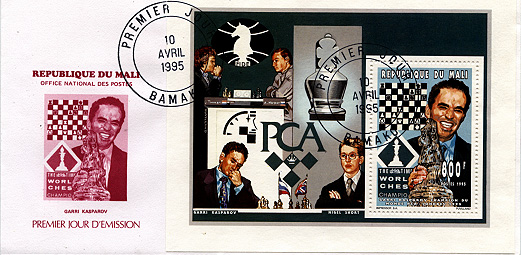
Short v Kasparov, match (23), 1993
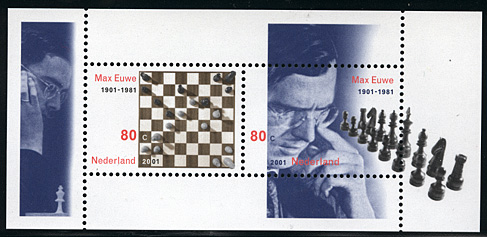
Chess positions on postmarks!
We have found three postmarks with chess positions. Perhaps readers of this page will know of others.
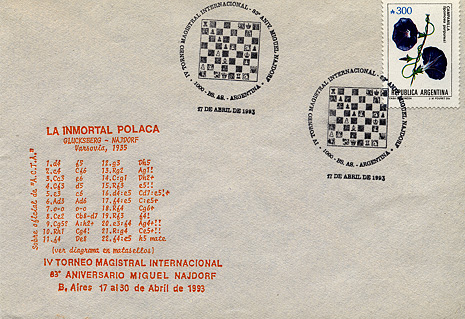
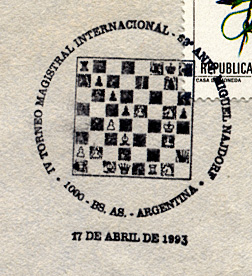
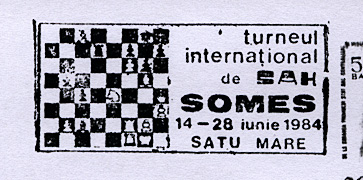
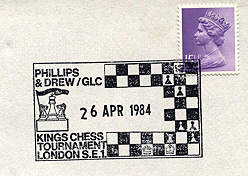
A disappointment here... a postmark containing a fragment of a position, but there's not enough for ChessBase to find a real game. Any ideas?
Bibliography
Dr. Raphel Ruppin, "Game Positions on Stamps," ChessStamp Review #28
Harold Beagle, "British Virgin Islands Salutes American Moves in Chess," ChessStamp Review #30
Andrew Katz, "Errors in the Design of Chess Stamps," ChessStamp Review #33
Conrad Goodman, "New/Old Issues and Varieties," ChessStamp Review #47
P.C. Burnett, "Jugoslav Chess Issue from 1950," ChessStamp Review #60
Joram R. Lubianiker, "The Design of Laos 88," ChessStamp Review #61
Joram R. Lubianiker, "Letter to the Editor," ChessStamp Review #67
Joram R. Lubianiker, "Game Positions on Stamps: Review and Completion," ChessStamp Review #70
Joram R. Lubianiker, "Armenia 1996 Chess Issues," ChessStamp Review #85
Joram R. Lubianiker, "New Game Positions on Stamps - Part 1," ChessStamp Review #96
Joram R. Lubianiker, "New Game Positions on Stamps - Part 2," ChessStamp Review #97
Joram R। Lubianiker, "New Game Positions on Stamps - Part 3," ChessStamp Review #98
Source
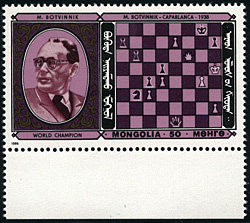
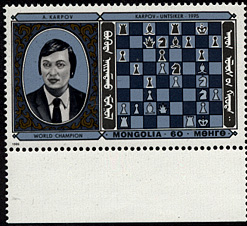



There's a British stamp featuring chess, from 1976. You can see it here: http://www.collectgbstamps.co.uk/displayset.asp?setid=146
ReplyDelete